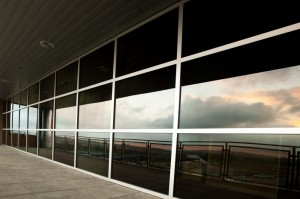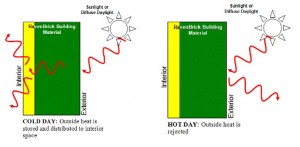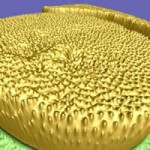This post was going to focus on the first building in Canada to feature ‘smart’ windows. In this case, they are electrochromic windows and the company, View Dynamic Glass, was mentioned here in a September 17, 2018 posting about the windows’ use at the Dallas/Fort Worth Airport. (The posting includes a link to the View Dynamic Glass report on the windows’ use and a short video.)
However, things changed but, first, let’s start with an explanation as to what electrochromic glass ir. Chris Woodford in a December 5, 2018 article on explainthatstuff.com offers a great overview which includes an explanation, a description of how they work, and more. What follows is a brief excerpt from Woodford’s overview (Note: Links have been removed),
What is electrochromic glass?
Glass is an amazing material and our buildings would be dark, dingy, cold, and damp without it. But it has its drawbacks too. It lets in light and heat even when you don’t want it to. On a blinding summer’s day, the more heat (“solar gain”) that enters your building the more you’ll need to use your air-conditioning—a horrible waste of energy that costs you money and harms the environment. That’s why most of the windows in homes and offices are fitted with curtains or blinds. If you’re into interior design and remodeling, you might think furnishings like this are neat and attractive—but in cold, practical, scientific terms they’re a nuisance. Let’s be honest about this: curtains and blinds are a technological kludge to make up for glass’s big, built-in drawback: it’s transparent (or translucent) even when you don’t want it to be.
Since the early 20th century, people have got used to the idea of buildings that are increasingly automated. We have electric clothes washing machines, dishwashers, vacuum cleaners and much more. So why not fit our homes with electric windows that can change from clear to dark automatically? Smart windows (also referred to by the names smart glass, switchable windows, and dynamic windows) do exactly that using a scientific idea called electrochromism, in which materials change color (or switch from transparent to opaque) when you apply an electrical voltage across them. Typically smart windows start off a blueish color and gradually (over a few minutes) turn transparent when the electric current passes through them.
…
As for the news about its Vancouver debut, I was very excited to see this April 28, 2019 article by Kenneth Chan for dailyhive.com/vancouver,
…
BlueSky Properties’ 10-storey office building at 988 West Broadway [in Vancouver, Canada; emphasis mine] is home to the new Vancouver offices of Industrial Alliance Financial Group, which has leased nine stories and 93,700-sq-ft of office space.
…
One of the building’s unique design features is its use of View Dynamic Glass technology [emphases mine] — a glass technology that controls heat and glare, reduces overall energy consumption and costs, and improves the health and wellness of individuals working inside the building.These smart windows optimize the amount of natural light to enhance mental and physical well-being without the need for shades or blinds. The application of the technology on this building, the first of its kind in Canada, will result in energy savings of up to 20%, [emphasis mine] with the amount of sunlight streaming through automatically tinted to block glare.
…
Blue Sky Properties (a Bosa Family Company), the local developer for this building, was very excited about the building and the ‘smart’ glass technology, according to its April 23, 2019 news release (here for a short version and here for the full version).
Other than being happy to see the technology being employed in Vancouver, I didn’t spend a lot of time thinking about the property. That changed on reading a May 8, 2019 article by Kenneth Chan for dailyhive.com/vancouver,
A structural engineer based in Vancouver has been stripped of his license to work in British Columbia [emphasis mine] following an investigation that determined his design for a condominium tower in Surrey fell short of the provincial building code.
According to a disciplinary notice posted by Engineers and Geoscientists British Columbia Association (EGBCA) on April 30, John Bryson, a managing partner of Bryson Markulin Zickmantel Structural Engineers (BMZSE), [emphases mine] admitted to unprofessional conduct and acted contrary to the association’s code of ethics that requires its members to “hold paramount the safety, health, and welfare of the public.”
“Mr. Bryson admitted that his structural design for the building did not comply with the 2006 BC Building Code, to which he certified it had been designed, in particular with respect to seismic and wind loads,” reads the notice. [emphases mine]
…
BMZSE has been involved in the design work of a number of projects across Metro Vancouver, including Station Square, Rogers Arena South Tower, Lougheed Heights, River District Parcel 17, The Jervis, Harwood, Plaza 88, Solo District, Burrard Place, Centreview Place, Trump International Hotel & Tower Vancouver, Central, Sovereign, Kings Crossing, and 988 West Broadway. [emphases mine]
You can find the ‘disciplinary notice’ (it’s an account of what Bryson failed to do and the punishment for the failure) here on the Association of Professional Engineers and Geoscientists of the Province of British Columbia (also known as Engineers and Geoscientists British Columbia) website.
Presumably, all of Bryson’s projects have been reviewed since the disciplinary action.




